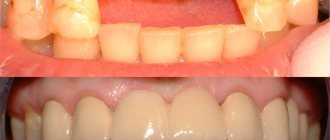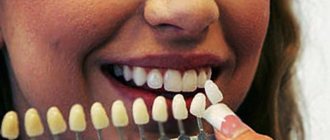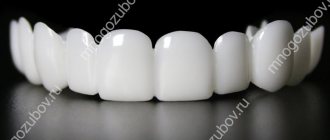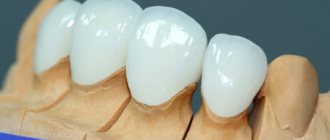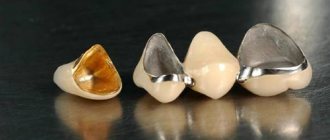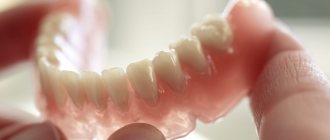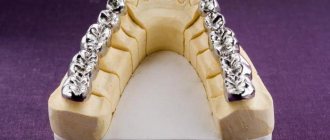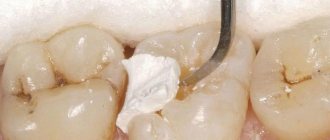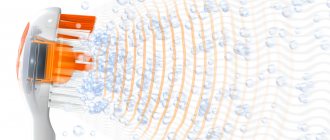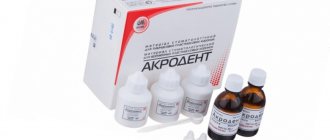In addition, fiberglass is absolutely biologically and chemically inert, therefore it does not cause inflammatory reactions or rejection. Even from an electrochemical point of view it is passive. However, due to the fact that fiberglass is a relatively new dental material, many doctors are not familiar with its bonding techniques. Moreover, the surface of pins made from it has low adhesion, as a result of which standard light-curing composite “cement” is not fixed to it.
Fiberglass pins - a new word in aesthetic prosthetics
Very often, in the process of treating, for example, pulpitis or periodontitis, the dentist has to drill out large cavities, and in case of complicated lesions, remove the nerve of the tooth (depulpate). Thus, the tooth is deprived of the elements that ensure its strength, and the doctor’s task is to restore this strength. For this purpose, pins (fiberglass or anchor) are used in dentistry. This method has its pros and cons, scope of application and is increasingly attracting interest among therapists. This article will tell you why this happens.
What is a pin
Treatment of carious lesions (especially complicated ones) leads to significant excision of dentin, in other words, a small skeleton often remains of the tooth, which either rises very slightly above the gum or is level with it. Such a damaged crown requires restoration - both for aesthetic purposes and to maintain the functionality of the unit. Especially when it comes to the frontal group of teeth.
In such cases, doctors face a difficult task: not only to eliminate the aesthetic defect, but also to normalize the function of the hard tissues of the tooth. Prosthetics with a crown is useless in this case, because there is simply nothing to put it on. And then a relatively young invention comes to the doctor’s aid - a pin. The essence of its use is simple: it is inserted into a cleaned root canal, and a crown is built onto the end protruding above the gum.
Indications and contraindications
Indications for installing fiberglass pins:
- severe damage to the teeth in the lateral and frontal areas;
- restoration by extension onto a rod;
- installation of splinting structures;
- restoration with restoration mixtures;
- in case of destruction of jaw units after serious injuries, fragmentary restoration;
- for prosthetics (it is necessary to create a reliable support when using ceramic prostheses).
Contraindications:
- pathology of hard tissues;
- blood clotting is poor;
- the root part is used for support;
- chronic diseases of the nervous system, mental illness;
- caries;
- granulomas, soft tissue cysts;
- The thickness of the root part is insufficient.
Types of pins
Anchor (metal) pins have been used in dentistry for a very long time, but they have a number of disadvantages. They are hard and often lead to root deformation or even fracture; they can cause allergic reactions and destroy dentin by oxidizing.
However, they have been replaced by polymer posts, which are made from synthetic materials, and therefore have many advantages over their metal brothers.
Interesting! Cutting a fiberglass post is done only with a diamond cutter, because only this allows cutting without disturbing the structure of the pin. Shortening the product with another drill damages the outer layer, which means that bacteria can penetrate inside the cone, which will inevitably lead to its destruction.
Advantages and disadvantages
Advantages:
- there are no large volumes of tooth decay;
- the rod is elastic, its properties are as close as possible to the characteristics of dentin;
- uniform distribution of loads and pressure, restoration of dentition functions;
- the rods do not contain nickel, chromium, or other elements that negatively affect health or cause allergic reactions;
- light transmission is excellent;
- the ability to accurately select the shade of enamel;
- Removing the structure if necessary is simple.
Flaws:
- There are risks of chipping due to insufficient experience of the doctor or violation of prosthetic technology.
Pros of fiberglass pins
- preserve the structure of the tooth and its tissues,
- do not lead to root fracture,
- due to its flexibility, it can be installed in teeth with complex root canal patterns,
- do not corrode,
- have biological and chemical inertness, hypoallergenic, non-toxic, non-carcinogenic,
- passive from an electrochemical point of view, that is, they do not generate galvanic current in the presence of other metal structures in the mouth (braces, crowns, bridges, etc.),
- radiopaque,
- easily removed from the root canal if replacement is required,
- allow you to create a tooth crown in one visit, avoiding the involvement of additional specialists and laboratories,
- have a low cost (compared to anchor pins),
- allow you to achieve excellent aesthetic results of restoration.
Stages of installing a crown on a pin
- Initial consultation, determination of indications and contraindications for treatment.
- Preparation of tooth tissues and depulpation of root canals.
- Installation of the pin.
- Taking impressions or 3D modeling. Sending the results to the laboratory to make a permanent crown. Immediately after the procedure, the patient is offered a temporary crown.
- Trying on the finished product and fixing the crown with a pin.
Disadvantages of polymer orthopedic rods
There are not many disadvantages to such products - they mainly concern the pins in general. Thus, their surface has low adhesion, so light-curing (for example, glass ionomer) composite material is rather poorly attached to it. This reduces the service life of fiberglass models compared to anchor models. In addition, their fixation requires manual skill from the doctor (because the pin is installed by the same doctor who treated the tooth). When installed in a tooth with tortuous canals, where there are microvoids, it may collapse because the voids will put additional stress on the resin.
Well, in principle, this is an inexpensive, but not the best solution for restoring a tooth, because the load on the root is distributed unevenly, which can lead to its rapid fracture.
Why should you contact TriDental dentistry?
Our clinic has been on the market for many years and throughout this time we have only positive reviews and letters of gratitude from clients. Our advantages:
- affordable prices for installing fiberglass fonts;
- licenses and certificates are available;
- We have only qualified doctors on staff - we value our reputation;
- Before any procedure, a full examination of the oral cavity is carried out, which makes it possible to identify concomitant diseases;
- All services are guaranteed, and certified drugs are used for anesthesia;
- no need to sit in queues - we have pre-registration of patients.
If you have any questions about the cost and installation time of fiberglass fonts, you can always contact our specialists through the feedback form on the website or by phone.
Method of placing fiberglass pins
To securely bond the fiberglass product, the doctor must first prepare the tooth. After completing the therapeutic part, depulpation (removal of the nerve) and cleaning of the canal is carried out. It is etched with a weak solution of phosphoric acid, and not only the internal cavity is treated with it (no more than 15 seconds), but also the surface of the crown (30-60 seconds). Next, the tooth is washed with distilled water, dried with paper pads and treated with a preparation containing collagen fibers. They are the ones who must ensure the adhesiveness of the product. After this, the process of installing the rod begins.
Stages of placing a fiberglass microprosthesis
- the pin is degreased with a solution of acetone, chloroform, alcohol or anhydrine, coated with two layers of a bonding agent (for example, the LuxaBond system),
- Composite material is placed into the tooth canal and evenly distributed along the walls of the hole. The surface of the pin is treated with the same composite,
- place the rod inside the tooth and cure the filling material with a photopolymerization lamp,
- after this, restoration of the supragingival part of the crown begins. This process is individual and depends on the degree of tooth decay, its place in the jaw and the clinical picture. This could be simply a composite restoration, or a classic crown made from absolutely any materials.
Important! Double-curing bonding agents have high chemical activity, so they are firmly bonded not only to the filling material, but also to dentin. Thus, tight fixation of the fiberglass pin and tightness of the root canals is achieved.
Service life and design reliability
The service life of a crown on a tooth on a pin is quite decent if the treatment was carried out efficiently, and the patient avoided injury and followed the doctor’s recommendations. Even a classic metal-ceramic crown with a simple anchor pin costs on average 7–8 years. A more expensive ceramic crown on a fiberglass post will last even longer.
If during use the crown begins to wobble, then this is a bad sign, regardless of whether it is with a pin or without a pin. In this case, you need to consult a doctor as soon as possible. If the crown and pin fall out completely, this may be due to improper treatment, pathological processes in the root canals, or a banal injury. Repeated treatment in most cases is no longer possible.
Manufacturers of polymer pins
Glassix
Manufacturer: Swiss company HaraldNordin. Specializes in the production of pins with rounded ends. They have three different diameters - 1.20 mm, 1.35 mm and 1.50 mm. They are characterized by high strength, elasticity and light conductivity. In addition, Glassix fiberglass is similar in structure to dentin, which facilitates restoration work and reduces differences at the interface between the artificial and natural areas. The price of one product starts from 800 rubles.
Ikadent
The manufacturer is the Russian company Ikadent, whose products can be equal in quality to their Western counterparts. It produces a whole range of orthopedic rods: cylindrical with a rounded end; cylindrical-conical with diameters (1.25 mm, 1.4 mm, 1.55 mm); a rod with a collar (a build-up at the end that allows for volumetric tooth restoration). Ikadent pins are highly durable, do not require additional processing to increase adhesion and allow you to restore teeth in case of total destruction of the supragingival part of the crown. The cost of one product varies from 1500 to 2500 rubles.
Relyx Fiber Post
Manufacturer – USA. These orthopedic rods are available in three modifications with diameters of 1.3 mm, 1.6 mm and 1.9 mm, and their unique design allows you to fill the canal without creating pores. They are distinguished by high strength and good aesthetic characteristics. The price per piece varies from 4,000 to 6,000 rubles.
EasyPost
The manufacturer is a French company of the same name. It differs from other fiberglass products in its transparency, therefore it is widely used in the restoration of anterior teeth. The strength of these orthopedic rods is achieved by treating glass fibers with zircon. The cost of one unit is 4000-600 rubles.
Fibrapost Lux
Country of origin: Switzerland. Fibrapost Lux rods have the following competitive advantages: radiopacity, resistance to bending and twisting due to special weaving, and the presence of microgrooves that increase attachment to the canal walls. The transparency of the pins allows them to be installed in the teeth of the smile zone. The price of one product starts from 5,000 rubles.
